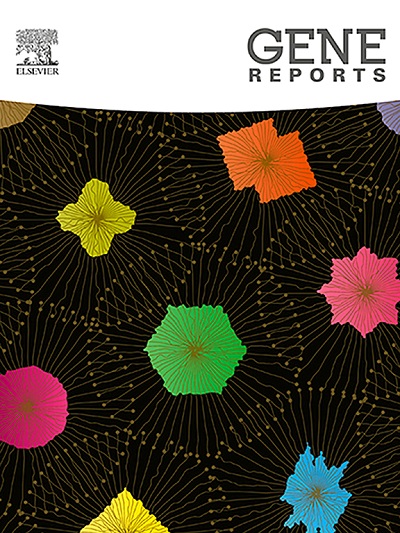2 型糖尿病患者的 FDXR 基因表达和微核频率及其在辐照情况下的重要性
IF 1
Q4 GENETICS & HEREDITY
引用次数: 0
摘要
对血液样本中基因表达(如铁氧化还原酶:FDXR)变化的分析表明,该方法具有预测疾病、治疗预后以及辐射暴露人群分流和剂量估算的潜力。同样,微核(MN)形成的量化也被作为一种快速细胞遗传标记用于这些应用。需要提醒的是,能否将这些标记可靠地用于疾病预测、治疗预后和剂量估计,取决于影响这些标记的已知变量的信息。文献表明,糖尿病条件下的高级糖化终产物/氧化应激可改变 DNA 损伤水平和基因表达,并影响核灾难中暴露与未暴露人群的分离。因此,我们研究了 2 型糖尿病(T2DM)对 FDXR 基线表达和 MN 频率的影响。我们采集了健康志愿者(60 人,其中男性 43 人,女性 17 人)和 T2DM 患者(60 人,其中男性 32 人,女性 28 人)的外周血样本,并使用显微镜对 FDXR 基因表达进行了实时量化和 MN 频率分析。与 HV 相比,T2DM 患者的 FDXR 基因表达基础水平(2.55 倍)(p <0.01)和 MN 频率(4 倍)显著较高(p <0.01)。此外,亚组分析发现,在 T2DM 患者中,性别、酗酒、吸烟、T2DM 病程、并发症和药物均会增加 FDXR 基因的表达和 MN 的发生频率;然而,除了性别(p < 0.05)和药物(p < 0.05)对 MN 发生频率的影响外,其他影响均不显著。总体结果表明,T2DM 患者的 FDXR 基因基础表达水平和 MN 频率高于 HV,这表明 T2DM 代谢状况的改变是影响这些标记物水平的一个混杂因素。在大规模放射事故中,可能需要考虑这些标记物水平的增加,以监测医疗辐射照射和可靠的生物模拟。本文章由计算机程序翻译,如有差异,请以英文原文为准。
FDXR gene expression and micronucleus frequency in Type 2 diabetes mellitus patients and their importance in case of radiation exposures
Analysis of gene expression (e.g. Ferredoxin Reductase: FDXR) changes in the blood samples have shown potential as predictive markers of disease, prognosis for therapy as well as triage and dose estimation in radiation-exposed populations. Similarly, quantification of micronuclei (MN) formation has been presented as a rapid cytogenetic marker for those applications. It was cautioned that the reliable utilization of these markers for prediction of disease, therapy prognosis, and dose estimation depends upon the information on known variables that affect these markers. Literature suggests that advanced glycation end products/oxidative stress in diabetic conditions can alter the levels of DNA damage and gene expression, and impact the segregation of the exposed from unexposed during nuclear disasters. Therefore, we investigated the influence of Type 2 diabetes mellitus (T2DM) on baseline expression of the FDXR and frequency of MN. Peripheral blood samples were collected from healthy volunteers (HV) (n = 60; 43 males and 17 females) and T2DM patients (n = 60; 32 males and 28 females), and performed real-time quantification of FDXR gene expression and analysis of MN frequency using microscopy. The basal level of FDXR gene expression (2.55 folds) (p < 0.01) and the frequency of MN is significantly (p < 0.01) higher (4 folds) in T2DM patients when compared to HV. Further, subgroup analysis found that gender, alcohol, smoking, duration of T2DM, complications, and medications increased both the expression of the FDXR gene and frequency of MN in T2DM; nevertheless, the increase was not significant, except for gender (p < 0.05) and medication (p < 0.05) on the frequency of MN. Overall results indicate that the T2DM patients showed a higher basal level expression of the FDXR gene and MN frequency when compared to HV and suggest an altered metabolic condition in T2DM is a confounding factor that impacts the levels of those markers. The increased levels of these markers might need to be considered to monitor medical radiation exposures and reliable biodosimetry during large-scale radiological accidents.
求助全文
通过发布文献求助,成功后即可免费获取论文全文。
去求助
来源期刊

Gene Reports
Biochemistry, Genetics and Molecular Biology-Genetics
CiteScore
3.30
自引率
7.70%
发文量
246
审稿时长
49 days
期刊介绍:
Gene Reports publishes papers that focus on the regulation, expression, function and evolution of genes in all biological contexts, including all prokaryotic and eukaryotic organisms, as well as viruses. Gene Reports strives to be a very diverse journal and topics in all fields will be considered for publication. Although not limited to the following, some general topics include: DNA Organization, Replication & Evolution -Focus on genomic DNA (chromosomal organization, comparative genomics, DNA replication, DNA repair, mobile DNA, mitochondrial DNA, chloroplast DNA). Expression & Function - Focus on functional RNAs (microRNAs, tRNAs, rRNAs, mRNA splicing, alternative polyadenylation) Regulation - Focus on processes that mediate gene-read out (epigenetics, chromatin, histone code, transcription, translation, protein degradation). Cell Signaling - Focus on mechanisms that control information flow into the nucleus to control gene expression (kinase and phosphatase pathways controlled by extra-cellular ligands, Wnt, Notch, TGFbeta/BMPs, FGFs, IGFs etc.) Profiling of gene expression and genetic variation - Focus on high throughput approaches (e.g., DeepSeq, ChIP-Seq, Affymetrix microarrays, proteomics) that define gene regulatory circuitry, molecular pathways and protein/protein networks. Genetics - Focus on development in model organisms (e.g., mouse, frog, fruit fly, worm), human genetic variation, population genetics, as well as agricultural and veterinary genetics. Molecular Pathology & Regenerative Medicine - Focus on the deregulation of molecular processes in human diseases and mechanisms supporting regeneration of tissues through pluripotent or multipotent stem cells.
 求助内容:
求助内容: 应助结果提醒方式:
应助结果提醒方式:


